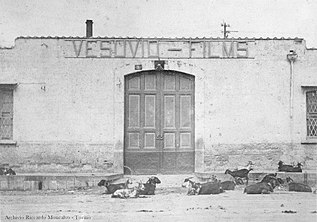Cinema of Naples
Naples played a prominent role in the rise of another industry of movement: the motion picture industry.
The history of
History
19th century

During his stay in Naples in 1888, the French inventor
In May 1898 the Paduan Mario Recanati, considered the first in Italy to distribute and trade films, opened the first cinema in Galleria Umberto I at number 90;[6] in that year, the new invention was also used for advertising purposes, achieving such success as to worry the Naples Police Headquarters.[5]
20th century
From the start of the century to the First World War
In the early years of the twentieth century, the first Italian film house, namely the Titanus (originally Monopolio Lombardo),[7] was built in the city, in the Vomero district. Founded by Gustavo Lombardo in 1904, it is the largest and probably the most famous film house in the country.[8]
The first short film is due to Roberto Troncone who shot Il ritorno delle carrozze da Montevergine in 1900; he filmed the eruption of
In 1906 the city newspapers, faced with the success of cinema, witnessed by the twenty-seven cinemas, spoke of an "epidemic":[5] the inauguration of the International Cinema caused riots, put down by the police and it was thought to widen Piazza Carità to solve the problems of circulation caused by the presence of this room.[5] In 1908, six of the seven film magazines published in Italy were Neapolitan and Gustavo Lombardo's «Lux» magazine was also widespread abroad.[5][10]

In 1907, with La dea del mare by
Around 1913, Giuseppe Di Luggo's Polifilms company was officially founded.
Film Dora was born around 1909, subsequently becoming Dora Film, with Elvira Notari at work as director, screenwriter and producer, of whose work the Library of Congress conserves some copies of A Piedigrotta,[20][21] opening in 1925 in New York City the Dora Film of America, for the public made up of emigrants[22] who will be able to see them with the titles of Mary the Crazy Woman, Blood and Duty, The Orphan of Naples and From Piave to Trieste.[19] Brunetta also defined his films «events inspired by successful songs, or taken from drama, stories of street urchins and "piccerille" (children) who get lost».[19] Family-run production house, after starting to color the films, it went on to produce, with Elvira Notari at the helm, films based on plays by Federico Stella and Crescenzo Di Maio, aiming, according to the memory of her son Eduardo, to make «'o cinema de' napulitane» (the cinema of the Neapolitans).[21]
The period between the two wars
Even in the Fascist era, very little inclined to dialectal folklore, "local" films were born, some of real importance.
— Martini, pag. 218
In the two-year period 1924–1925 a third of Italian films were shot in the Neapolitan capital, in a shed located on the corner of via Cimarosa and via Aniello Falcone.
In the 1930s, however, film production moved to Rome, according to Goffredo Lombardo because his father Gustavo wanted to «change the production system and the quality of films»;[10] however, according to the historian Daniela Manetti because a provision of the censorship office for cinema in 1928 already constituted «A very serious limitation to the Neapolitan genre that Lombardo has made appreciated even outside the regional borders and a serious mortgage for Naples as a city of cinema».[10]
From the postwar period to the end of the century
The early
Two films taken from scripts and directed by
In 1981 Neapolitan legend
21st century
In the 21st century, the importance of Naples as a center of film production, filming location and film subject is established, with the release of internationally successful films such as
Neapolitan actors and directors awarded internationally
Among the Neapolitan actors,
Among the directors, Vittorio De Sica, who identified himself as a Neapolitan,[40] was awarded four times with an Oscar.[41]
Naples has also been widely represented in national and international cinematography: great directors have followed one another over the years, starting with the
Films set in Naples awarded internationally
The films set in Naples are cinematographic films produced in the Neapolitan city which include
Among the most important films set in Naples are:
History
The

From this experience, at the beginning of the twentieth century, the city became one of the poles of the nascent Italian film industry, together with
As is already the case in other European and American cities, due to the so constant and widespread presence of cinematographic reality in the city of Naples and its surroundings, the so-called cinematographic tourism has also developed here, which offers the possibility of visiting the places immortalized by the most great film directors (such as De Sica or Rossellini) in their films, organizing real itineraries and guided visits to the locations of the most famous films.[60]
The pioneering times of the Neapolitan film industry ended during the
Actuality
In the last ten years, thanks to the great work carried out by the Campania Region Film Commission, Naples has become one of the most loved sets in the world. Over 400 productions have decided to shoot films and TV series in Naples between 2015 and 2024.
References
- ^ David Clarke, The Cinematic City, Routledge, pag. 49 on Google Books.
- ^ CyberItalian. "Totò, un grande attore – parte 2 (Totò a great actor – part 2) – Cyber Italian Blog" (in Italian). Retrieved December 8, 2022.
- ^ Michele, De Lucia (November 27, 2021). "Antonio De Curtis aka Totò". CAMPANIA WELCOME. Retrieved December 8, 2022.
- ^ "Filming Location Matching "Naples, Campania, Italy" (Sorted by Year Descending)". IMDb. Retrieved December 8, 2022.
- ^ a b c d e f g Barbagallo, pages 139–144
- ^ ISBN 978-88-581-1861-0.
- ^ "Titanus, lo scudo nobile del cinema italiano". La Repubblica (in Italian). February 16, 2014. Retrieved December 8, 2022.
- ^ "La storia di Titanus". Titanus (in Italian). Retrieved December 8, 2022.
- ^ "Napoli nel Cinema". Napoli nel Cinema (in Italian). Retrieved December 8, 2022.
- ^ ISBN 978-88-917-1173-1.
- ^ OCLC 1136964212.
- ^ "Francesca Bertini". IMDb. Retrieved December 8, 2022.
- ^ a b "BERTINI, Francesca in "Enciclopedia del Cinema"". www.treccani.it (in Italian). Retrieved December 8, 2022.
- ISSN 0011-8524.
- ISBN 978-88-917-3071-8.
- ^ De Agostini. "Il cinema Grande storia illustrata volume nove". Istituto Geografico de Agostini (in Italian). Novara: 46.
- ^ a b "La storia della prima Cinecittà italiana al Vomero". Vomero Magazine (in Italian). April 4, 2016. Retrieved December 8, 2022.
- ^ "LOMBARDO, Gustavo in "Dizionario Biografico"". Treccani (in Italian). Retrieved December 8, 2022.
- ^ a b c Brunetta, vol. 1, pag. 32
- ^ Notari, Elvira. "Quando il cinema era donna". briganti.info (in Italian). Archived from the original on March 2, 2021. Retrieved December 8, 2022.
- ^ ISBN 978-0-691-02533-9.
- ^ "NOTARI, Elvira in "Enciclopedia del Cinema"". www.treccani.it (in Italian). Retrieved December 8, 2022.
- ^ Martini, pag. 218
- ^ "1950 | Oscars.org | Academy of Motion Picture Arts and Sciences". www.oscars.org. Retrieved December 8, 2022.
- ^ a b Oliveri, Ugo Maria; Rovinello, Mario; Speranza, Paolo. L'onda della libertà Le Quattro Giornate di Napoli tra storia, letteratura e cinema. Edizioni Scientifiche Italiane. p. 1.
- ^ "Le mani sulla città in "Enciclopedia del Cinema"". www.treccani.it (in Italian). Retrieved December 8, 2022.
- ^ Fusco, Gaetano. Le mani sullo schermo: il cinema secondo Achille Lauro. Liguori Editore. p. 73.
- ISBN 978-88-6036-582-8.
- ^ "Cento film e un'Italia da non dimenticare". Movieplayer.it (in Italian). Retrieved December 8, 2022.
- ^ "Ecco i cento film italiani da salvare Corriere della Sera". www.corriere.it. Retrieved December 8, 2022.
- ISBN 978-88-8440-171-7.
- OCLC 61441685.
- ^ a b "La Stampa – Consultazione Archivio". www.archiviolastampa.it. p. 19. Retrieved December 8, 2022.
- ^ "Napoli, il cinema resiste: ecco i set ancora aperti". Corriere della Sera (in Italian). October 26, 2020. Retrieved April 23, 2023.
- ^ "Archivi Mario Franco - IL CINEMA A NAPOLI DALLE ORIGINI AD OGGI". Fondazione Morra (in Italian). Retrieved April 23, 2023.
- ^ "Lòren, Sophia nell'Enciclopedia Treccani". www.treccani.it (in Italian). Retrieved December 8, 2022.
- ^ "Totò nell'Enciclopedia Treccani". www.treccani.it (in Italian). Retrieved December 8, 2022.
- ^ "Troisi, Massimo nell'Enciclopedia Treccani". www.treccani.it (in Italian). Retrieved December 8, 2022.
- ^ "1955: Nastro d'argento a Tina Pica, regina del cinema –". Rai Teche (in Italian). March 30, 2017. Retrieved December 8, 2022.
- ^ "Foto e lettere inedite di De Sica, il ciociaro cosmopolita che voleva essere napoletano". Corriere del Mezzogiorno (in Italian). Retrieved December 8, 2022.
- ^ "VITTORIO DE SICA, UN ITALIANO CON 4 OSCAR". VeniVidiVici (in Italian). September 17, 2018. Retrieved December 8, 2022.
- ^ "Mario Monicelli e Rap – 100 anni di cinema". www.comune.napoli.it (in Italian). Retrieved December 8, 2022.
- ^ "Pasolini e Napoli 'Caro Eduardo giriamo un film' – la Repubblica.it". Archivio – la Repubblica.it (in Italian). Retrieved December 8, 2022.
- ^ IDN, Redazione (June 24, 2015). "Maccheroni di Ettore Scola – Itinerari di Napoli" (in Italian). Retrieved December 8, 2022.
- ^ "Tornatore: 'Senza Napoli non avrei mai fatto il regista'". Repubblica TV – Repubblica (in Italian). February 9, 2015. Retrieved December 8, 2022.
- ^ "Gabriele Salvatores: "Il mio ragazzo invisibile è nato in una scuola di Secondigliano"". la Repubblica (in Italian). January 3, 2018. Retrieved December 8, 2022.
- ^ "Napoli, il primo ciak del nuovo film di Matteo Garrone". Informareonline (in Italian). September 25, 2017. Retrieved December 8, 2022.
- ^ Esposito, Roberta (June 1, 2014). "Video. La passione napoletana firmata John Turturro". Vesuvio Live (in Italian). Retrieved December 8, 2022.
- ^ "Paisà". cinematografo.it (in Italian). Retrieved December 8, 2022.
- ^ "Premi del cinema 1955". Wayback Machine (in Italian). February 20, 2017. Archived from the original on February 20, 2017. Retrieved December 8, 2022.
- ^ "Matrimonio all'italiana". cinematografo.it (in Italian). Retrieved December 8, 2022.
- ^ "1965 | Oscars.org | Academy of Motion Picture Arts and Sciences". www.oscars.org. Retrieved December 8, 2022.
- ^ "CAROSELLO NAPOLETANO – Festival de Cannes". www.festival-cannes.com (in French). Retrieved December 8, 2022.
- ^ Vetrano, Dresiana. "Napoli ex Capitale anche del Cinema. Così il fascismo distrusse la Cinecittà napoletana". Identità Insorgenti (in Italian). Retrieved December 8, 2022.
- ^ "La prima casa cinematografica d'Italia è nata a Napoli!". Grandenapoli.it. February 20, 2017. Retrieved December 8, 2022.
- ^ "cinema napoletano elvira notari" (in Italian). June 2006. Archived from the original on September 27, 2012. Retrieved December 8, 2022.
- ^ "Napoli nel Cinema". Napoli nel Cinema (in Italian). Retrieved December 8, 2022.
- ^ "Elvira Notari". enciclopedia delle donne (in Italian). Retrieved December 8, 2022.
- )
- ^ "Campania Movietour | In viaggio nei luoghi del cinema – A Cinematic Journey on Movie Locations". September 12, 2018. Archived from the original on September 12, 2018. Retrieved December 8, 2022.
- ^ Paliotti, Vittorio; Grano, Enzo (1969). Napoli nel cinema (in Italian). Azienda autonoma soggiorno cura e turismo. p. 167.
Bibliography
- Francesco Barbagallo, Napoli, Belle Époque, Editori Laterza. ISBN 978-88-581-2105-4
- ISBN 88-365-3442-2
- Giulio Martini, I luoghi del cinema, ISBN 88-365-3442-2
- Vittoria Ferrandino and Maria Rosaria Napolitano, FrancoAngeli, Storia d’impresa e imprese storiche. Una visione diacronica
- Emiliano Morreale, Così piangevano: il cinema melò nell'Italia degli anni Cinquanta, Donzelli Editore


